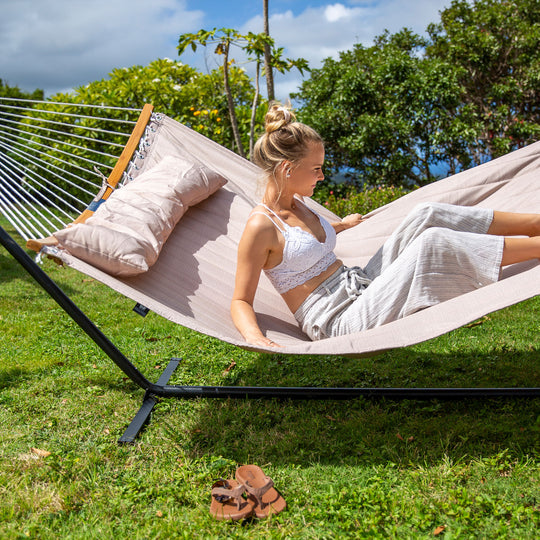SUNCREAT - Sept. 28th 2024
All About Hammocks with Bars
Hammocks have been a symbol of relaxation and comfort for centuries. Originally used by indigenous peoples in Central and South America, traditional hammocks provided a cocoon-like space, ideal for resting in comfort. However, over time, variations of the hammock have emerged, each offering unique benefits. One such innovation is the spreader bar hammock, a type that adds structure and stability to the hammock experience. In this article, we’ll dive into the origins, development, and current status of spreader bar hammocks and examine how they’ve become a staple in outdoor relaxation.
The Origins of Spreader Bar Hammocks
The history of hammocks dates back thousands of years, with the earliest designs made from plant fibers and woven by hand. These hammocks were suspended between trees and formed a snug cradle, ideal for sleeping or napping. However, they lacked structure, causing the fabric to bunch up and form a deep, curved shape. While this created a sense of security and comfort for many, it wasn't always ideal for activities like reading or sunbathing, where a flatter surface might be preferred.
In response to these limitations, spreader bar hammocks were invented in the 19th century, first appearing in Europe and North America. Craftsmen began adding wooden or bamboo bars at each end of the hammock, forcing the fabric to remain flat. This made the surface more even and less cocoon-like, which many found to be more practical for activities like relaxing, reading, or even socializing. Over time, spreader bar hammocks became a popular choice, especially in outdoor settings like patios and gardens, and were often seen as a symbol of leisure among the upper classes.
The Development of Spreader Bar Hammocks
As spreader bar hammocks grew in popularity, their design continued to evolve. In the mid-20th century, with the introduction of synthetic materials like nylon and polyester, spreader bar hammocks were no longer limited to natural fibers like cotton or jute. These new materials were not only more durable but also resistant to water and mildew, making them better suited for outdoor use. As a result, hammocks could be left outside for longer periods without the risk of weather-related damage.
The spreader bars themselves also evolved. Originally made from wood or bamboo, which are still common materials today, newer hammocks began incorporating aluminum and composite bars. These materials are lightweight yet strong, providing enhanced durability. They also have better resistance to wind and weather, further increasing the versatility of spreader bar hammocks in various climates.
Beyond materials, the design of spreader bar hammocks has also become more diverse. Designers have taken the opportunity to blend aesthetic appeal with function, resulting in hammocks that come in a wide variety of colors, patterns, and styles. From classic striped designs to modern geometric patterns, there’s a spreader bar hammock for every taste. Additionally, some newer models feature adjustable spreader bars, allowing users to customize the flatness or curve of the hammock based on their preferences. This flexibility has added another layer of comfort and personalization to the hammock experience.
The Current Popularity of Spreader Bar Hammocks
Today, spreader bar hammocks are an integral part of outdoor furniture collections across the globe. Their flat, open design makes them ideal for soaking up the sun, reading, or simply enjoying the view. Spreader bar hammocks are now found not only in private gardens and backyards but also in commercial spaces like beach resorts, hotels, and vacation homes.
However, spreader bar hammocks do come with a few limitations. The addition of the bars makes these hammocks slightly less stable compared to traditional hammocks. The flat surface can make it easier to flip over, particularly in windy conditions or when there’s movement on the hammock. As a result, spreader bar hammocks may require a sturdy stand or should be hung in a sheltered location. Some users even add safety ropes or anchors to prevent tipping.
Additionally, the tautness of the fabric in spreader bar hammocks can be less forgiving than the gentle cradle of a traditional hammock. While they are great for lying flat, some people may find them less comfortable for long periods of lounging compared to hammocks that mold more naturally to the body’s shape.
Innovations in Spreader Bar Hammocks
Despite their few drawbacks, spreader bar hammocks continue to evolve with new innovations aimed at improving comfort, stability, and design. One major development has been the introduction of curved spreader bars. Instead of the traditional straight bar, these bars are slightly arched, which allows the hammock to conform more closely to the user’s body. This enhances both comfort and stability, making the hammock feel more supportive and less prone to flipping. Curved bars also distribute weight more evenly, reducing pressure points and increasing overall comfort.
In addition to increased comfort, curved spreader bars offer a more visually appealing design. The arch of the bars gives the hammock a sleek, modern look that blends well with both indoor and outdoor spaces. Whether set up in a minimalist backyard or a bohemian patio, the curved spreader bar hammock adds an element of style and sophistication.
The Future of Spreader Bar Hammocks
Looking ahead, spreader bar hammocks are likely to continue evolving in both design and materials. As material science advances, we can expect to see even more durable and weather-resistant fabrics and bars. Future hammocks may be lighter, stronger, and more resistant to UV damage, mildew, and wear from the elements. Additionally, innovations in ergonomics will likely continue to focus on enhancing user comfort while maintaining the signature flat design that makes spreader bar hammocks unique.
Spreader bar hammocks have a rich history and continue to be a popular choice for outdoor relaxation. Their open, flat design offers a comfortable space for activities like sunbathing, reading, or simply enjoying the outdoors. While they may not have the same cocoon-like comfort as traditional hammocks, spreader bar hammocks make up for it with their stability, versatility, and aesthetic appeal.
As they continue to evolve, spreader bar hammocks will likely become even more comfortable and durable, offering a perfect blend of style and relaxation for future generations. Whether lounging in your backyard or relaxing at a resort, the spreader bar hammock provides a little slice of tranquility in our fast-paced world.







